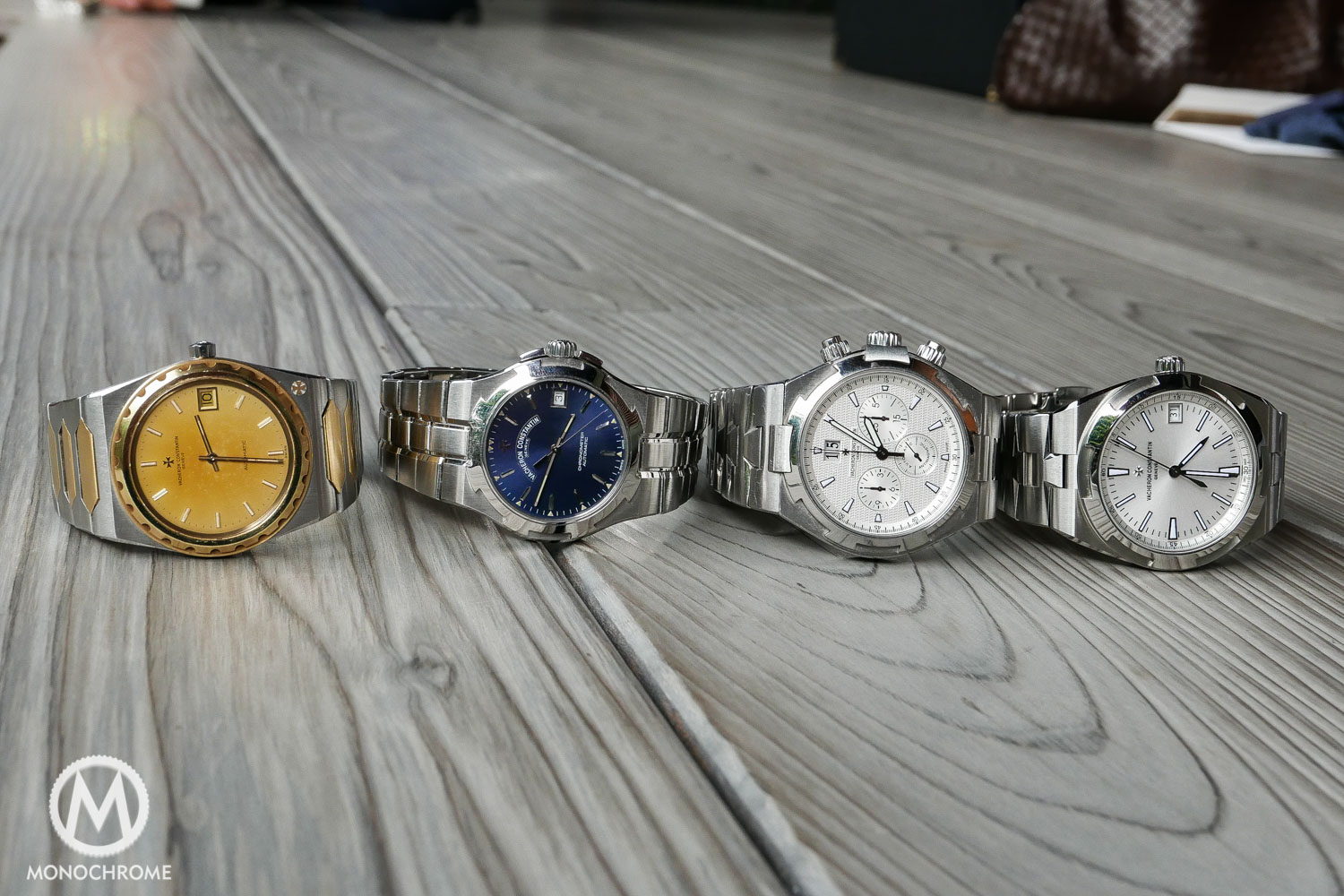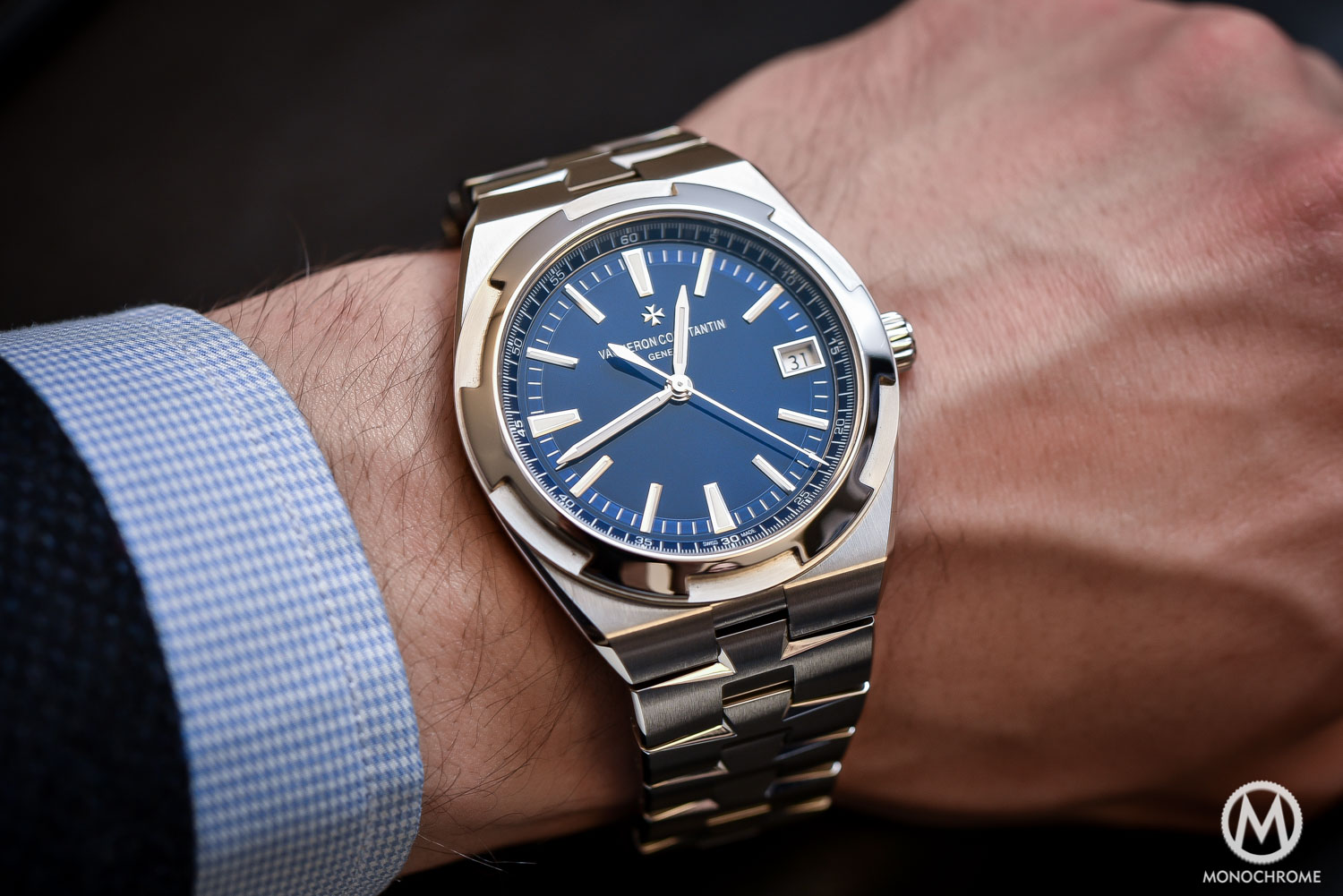The History of the Vacheron Constantin Overseas – The Other 1970s Icon
From the 222 to the modern Overseas collection.

In the 1970s, the post-war global economic boom came to an end. The new, accurate quartz watches gained popularity and plunged the Swiss watch industry in a deep crisis. As the inexpensive electronic watches began to flood the market, the competition from foreign manufacturers created a major economic turmoil, and with it, the need for Swiss brands to reinvent themselves, making necessary disruptive changes. And that includes the Vacheron Constantin Overseas, a watch born in that exact period.
It was at that time that Audemars Piguet decided to introduce something totally new. Together with the celebration of postmodernism, the 1970s style was all about freedom and eclectic, informal, laidback looks. To break away from their classic – somehow conservative – gold dress watches, Georges Golay, the brand’s managing director then, contacted Gerald Genta to design an entirely new genre of wristwatch.
Presented in 1972, the Royal Oak sparked a complete paradigm shift in the high-end Swiss watch industry. Genta’s avant-garde brainchild was a sporty yet elegant steel wristwatch whose bold case crowned with an octagonal bezel was extended with an integrated bracelet. The case and bracelet were designed as a whole rather than conceived separately. Despite fierce initial criticisms, his revolutionary vision turned into a huge international success, a game-changer creating a new category of timepieces.
The Audemars Piguet Royal Oak 5402ST and Patek Philippe Nautilus 3700/1A, two cult sport watches designed by Gérald Genta that shook up the horological world in the 1970s.
The vintage icon that precedes the Overseas: the Vacheron Constantin 222
The creation of the Royal Oak was followed by several other iconic high-end sport watches with integrated bracelet including the cult Patek Philippe Nautilus or the IWC Ingenieur, both designed by Genta. Not to be outdone, Vacheron Constantin, the oldest watch manufacturer in continuous operation (over 260 years), also introduced its luxury sport watch. To celebrate the brand’s 222 anniversary, Vacheron presented the “222”, designed by young Jorg Hysek. Like for Audemars Piguet and Patek Philippe, the 222 was a radical breakaway from their traditional dress watches.
The 37mm version of the Vacheron Constantin 222 with automatic movement (calibre VC1121 based on the JLC920).
Sharing signature hallmarks of the “Genta” design, the 222 also included distinctive features: a thin, barrel shaped case with a notched round bezel and a tiny Maltese cross inlaid at 5 o’clock. Its one-piece construction was water resistant to 120m. Its complex integrated bracelet was shaped with large, hexagonal center links. Underneath the clean dial with ‘baton’ markers, Vacheron used the VC1120 caliber, based on the Jaeger-LeCoultre caliber 920. Interestingly, this high-grade, trustworthy, ultra-flat automatic movement developed in the 1960s by Jaeger-Lecoultre was also used for the Royal Oak and the Nautilus.
The 222 was produced in different versions (37mm and 34 mm with automatic JLC based movements and 25mm with quartz movement) and materials (steel, gold and steel, and gold). Its shape went through iterations including a square version. Produced in limited quantities, the 222 was discontinued in the mid-1980s. It has now soared in popularity to become a 1970s horological icon.
A steel and gold version of the Vacheron Constantin 222
Within the sport offering of the brand, the 222 was followed by the 333 (sic), an octagonal case with integrated bracelet and then the Phidias, with round case and integrated bracelet proposed in different versions and with different functions such as chronograph or GMT indication by the mean of a rotating bezel.
A chronograph version of the Phidias from the mid-1990s.
The Vacheron Constantin Overseas Phase 1 (1996-2004)
The success for Vacheron Constantin sports watches really came in 1996 with the launch of the Overseas, a direct descendant of the 222. At that time, the Vendôme Luxury group (Richemont was holding 70% of Vendôme, the buy-out of minority shareholders would be completed a few months later) had just acquired Vacheron Constantin from Investcorp. The development of the Overseas had been initiated a few months before by a design team including Dino Modolo, an external watch designer and Vacheron Constantin’s Vincent Kaufmann. More than just a high-end sport watch, the overseas aimed at satisfying global travelers with an appetite for casual yet elegant statement pieces.
Like the 222, the Overseas was built around a tonneau shaped case with a fluted bezel reminiscent of the Maltese cross. Its dynamic lines were extended by an integrated bracelet with geometric links. The first overseas was 37mm, water resistant to 150m and powered by the VC1310, a COSC certified version of the ultra-flat automatic Girard-Perregaux 3100. Smaller versions at 35mm and 24mm were added. 1999 saw the introduction of a chronograph based on a Frédéric Piguet 1185 modified with the addition of a large date mechanism.
The 18k gold version of the Overseas powered by the VC13100 automatic caliber.
The Overseas chronograph powered by the VC1137 based on the FP1185 with the addition of a large date.
The Vacheron Constantin Overseas Phase 2 (2004-2016)
A second version of the Overseas was launched in 2004, with a more modern design, notably with its metal bracelet featuring a half Maltese cross motif and optimized for greater comfort. Its integration to the case was reworked and its center link was extended up to the bezel. The crown guard disappeared and new, patterned dials completed the overall sportier feel. Muscled up at 42mm, the Overseas 2 was relying on the VC1126 (JLC889-based) and the VC1137 (FP1185 with big date) while a soft iron antimagnetic screen gave the movement an all-around protection.
The time-and-date and chronograph versions of Overseas – second generation.
In 2006, a dual time Overseas was added to the collection, featuring second time zone, power reserve, day night and date indications. This useful (and somehow awaited complication given the travel background of the collection) was indicated by the VC1222 based on the JLC 920 that is also used by Audemars Piguet for the Royal Oak reference 26120.
The Overseas dual time.
A noteworthy evolution was introduced in 2007 as the Overseas came on leather strap for the first time with a US limited edition of 100 chronographs fit with a choice of alligator and rubber strap (another first for VC).
The Overseas US limited edition (2007) until then the Overseas had only been available on bracelet. This 100-piece series sports a 42mm steel case and was powered by the VC1137 (FP1185 base with big date addition at 12).
Given its commercial success, the line was animated with different materials, different functions – as complex as a perpetual calendar chronograph – and numerous other limited editions.
A 2011 perpetual calendar chronograph Overseas ‘boutique edition’ in steel and titanium bezel. Its screw down case back features a medallion engraved with the Amerigo Vespucci three-masted sailing ship.
The Vacheron Constantin Overseas Phase 3 (2016)
In 2016, Vacheron Constantin presented a revamped Overseas collection with a more elegant and refined style while retaining its distinctive character. The overall design (by Vincent Kaufmann) is cleaner with more fluid lines. If the case takes more of a barrel shape, a disc below the bezel underlines its round, enlarged opening. The Maltese-cross bezel now has 6 notches versus 8 previously and spread out to the very rim of the case. The case back no longer features naval engravings but a sapphire crystal revealing mechanics worth a close look: 3 new in-house movements, new complications and the return of a horological classic, the VC1120. Really quite something all the more as all new models bear the Geneva Seal and are fitted with convenient interchangeable straps/bracelets.
The 2016 Overseas powered by a new Vacheron Constantin 5100 automatic caliber. The VC5100 is manufactured according to the Geneva Seal requirements, sports superb finishing and is wounded thanks to a 22K gold rotor fully engraved with a compass rose. The ingenious interchangeability device for the bracelets/straps serves to release and secure them in place without any need for tools.
The third generation of Overseas today comprises 6 models, 18 references in total.
- Ultra-thin perpetual calendar, diameter 41.5mm, caliber VC1120QP (JLC 920+module)
- Chronograph, diameter 42.5mm, caliber VC5200 (new in-house column wheel chronograph)
- Worldtime, diameter 43.5mm, caliber 2460 WT
- Ultrathin, diameter 40mm, caliber 1120 (JLC920 base)
- Time-and-date, diameter, 41mm, caliber 5100 (new in-house caliber)
- Small model, 37mm, caliber 5300 (new in-house caliber)
The 40mm Ultra-Thin Overseas marks the return of an horological icon, the VC1120, today manufactured in-house and based on the design of the JLC920, the cult ultra-flat automatic movement that was powering in the original Royal Oak, Nautilus and 222. More than just a “mechanical exception”, this emblematic, high-grade caliber celebrates the very spirit of the Overseas. Its elegant, thin case is an ultimate statement of sporting chic.
The Overseas ultra-thin powered by the automatic VC1120 caliber comes in 18k white gold with an elegant ruthenium-colored dial.
The impressive revised Overseas collection is enriched with new complications in the form of an uber-elegant ultra-thin perpetual calendar also based on the VC1120 and a worldtimer, the largest piece in the collection at 43.5mm and a befitting complication as travel is a leitmotiv of the collection.
The sophisticated Overseas Ultra-Thin Perpetual Calendar illustrates the overall shift of the collection’s styling. Its movement with moon phase is only 4.05 mm thick while the case is 8.1 mm.
The Overseas Worldtime on black rubber strap and the world map depicted on the center dial surrounded by 37 city names.
Last, the new generation of Overseas was also the opportunity for Vacheron Constantin to introduce three new calibers. The 5200 is an in-house integrated column-wheel chronograph with vertical clutch and automatic winding. The 5100 and 5300 new automatic calibers with respective dimensions of 13’’’¼ and 9’’’¾.
The new Overseas Chronograph no longer features a large date indication but is powered by a new Vacheron Constantin Chronograph.
The VC5200 chronograph and its column-wheel shaped in the form of a Maltese cross.
The age of maturity
If you go as far back as 1977 with the launch of the 222, the Overseas will soon turn 40. The age of maturity? Like the Audemars Piguet Royal Oak or the Patek Philippe Nautilus, it has stood the test of time to become iconic. The impressive revamp of the collection in 2016 is a new milestone further installing the Overseas as a versatile, casual elegant timepieces, duly forming part of the elite of the high-end luxury sport watch. But after all, 40 years in the life of an icon sounds like just the beginning…
The Overseas 1,2 and 3. From left to right, the Overseas 2 Chronograph, the Overseas 3 Worldtime, the Overseas 1 and the Overseas 3 Time-and-Date


























5 responses
Hi Xavier, thanks for sharing this interesting story; despite the Overseas is iconic to VC in my opinion can’t be compared to the Nautilus or Royal Oak – which are milestones in the world of wristwatches.
Of course, only personal opinion.
Regards,
slide68
Very nice review!
I am looking forward that another Overseas will soon join my little collection: The 4500V Blue Dial will be a wonderful addition to my black 49150 and silver 47040.
Why, was the Overseas Gen 2, referred to as the deep stream?
@mike the ‘Deep Stream’ refers to the Overseas II steel, titanium bezel, grey dial. I have checked with VC and they don’t have any explanation about how this nickname appeared. A beautiful watch, which is a good reason to earn a nickname.
Thank you for not calling the anti-magnetic cover a “Faraday Cage”, which it is not. That works on the electric field of an electromagnetic wave, not the magnetic field.